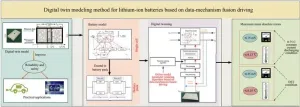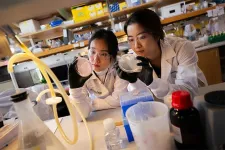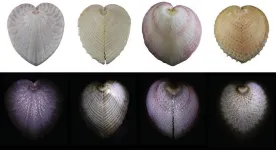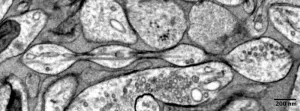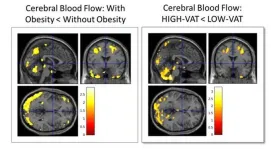(Press-News.org) Researchers at EPFL and Lausanne University Hospital (CHUV), led by professors Grégoire Courtine and Jocelyne Bloch, have achieved a major milestone in the treatment of spinal cord injuries (SCI). By applying deep brain stimulation (DBS) to an unexpected region in the brain—the lateral hypothalamus (LH)—the team has improved the recovery of lower limb movements in two individuals with partial SCI, greatly improving their autonomy and well-being.
Wolfgang Jäger, a 54-year-old from Kappel, Austria, has been in a wheelchair since 2006 after a ski accident left him with a spinal cord injury. Participating in the clinical trial, he experienced firsthand how deep brain stimulation could restore his mobility and independence. “Last year on vacation, it was no problem to walk a couple of steps down and back to the sea using the stimulation,” Jäger shared, describing the newfound freedom DBS has given him. Beyond walking, the therapy has improved everyday tasks. “I can also reach things in my cupboards in the kitchen,” he added.
DBS is a well-established neurosurgical technique that involves implanting electrodes into specific brain regions to modulate neural activity. Traditionally, DBS has been used to treat movement disorders like Parkinson’s disease and essential tremor by targeting areas of the brain responsible for motor control. However, applying DBS to the lateral hypothalamus to treat partial paralysis is a novel approach. By focusing on the LH, the researchers at .Neurorestore tapped into an unexpected neural pathway that had not been considered before for motor recovery.
In the study published in Nature Medicine, not only did the DBS show immediate results to augment walking during rehabilitation, but patients also showed long-term improvement that persisted even when the stimulation was turned off. These findings suggest that the treatment promoted a reorganization of residual nerve fibers that contribute to sustained neurological improvements.
“This research demonstrates that the brain is needed to recover from paralysis. Surprisingly, the brain is not able to take full advantage of the neuronal projections that survive after a spinal cord injury. Here, we found how to tap into a small region of the brain that was not known to be involved in the production of walking in order to engage these residual connections and augment neurological recovery in people with spinal cord injury,” says Courtine, professor of neuroscience at EPFL, Lausanne University Hospital (CHUV) and UNIL and co-director of the .NeuroRestore center.
Fundamental neuroscience combined with neurosurgical precision
The success of this DBS therapy hinged on two complementary approaches: discoveries enabled by novel methodologies in animal studies and the translation of these discoveries into precise surgical techniques in humans. For the surgery, the researchers used detailed brain scans to guide the precise locations of the small electrodes into the brain, performed by Bloch at CHUV, while the patient was fully awake.
“Once the electrode was in place and we performed the stimulation, the first patient immediately said, ‘I feel my legs.’ When we increased the stimulation, she said, ‘I feel the urge to walk!’ This real-time feedback confirmed we had targeted the correct region, even if this region had never been associated with the control of the legs in humans. At this moment, I knew that we were witnessing an important discovery for the anatomical organization of brain functions,” says Bloch, neurosurgeon and professor at the Lausanne University Hospital (CHUV), UNIL and EPFL, and co-director of the .NeuroRestore centre.
The lateral hypothalamus’ role in walking recovery
The identification of the LH as a key player in motor recovery after paralysis is in itself an important scientific discovery, given that this region has traditionally only been associated with functions like arousal and feeding. This breakthrough emerged from the development of a novel multi-step methodology that began with whole-brain anatomical and functional mapping to establish the role of this region in walking, followed by experiments in preclinical models to establish the precise circuits involved in the recovery. Ultimately, these results led to clinical trials in human participants.
“It was fundamental research, through the creation of detailed brain-wide maps, that allowed us to identify the lateral hypothalamus in the recovery of walking. Without this foundational work, we would not have uncovered the unexpected role this region plays in walking recovery," says Jordan Squair, a lead author of the study.
The advanced imaging platform at the Wyss Center played a critical role in this research by providing high-resolution imaging capabilities that enabled the team to map the anatomical and functional activity of neurons across the brain, enabling the identification of the lateral hypothalamus.
Combining DBS with spinal implants for enhanced recovery
These remarkable results pave the way for new therapeutic applications to augment recovery from SCI. Future research will explore integrating DBS with other technologies, such as spinal implants that have already shown their potential in restoring movement after SCI. “Integrating our two approaches—brain and spinal stimulation—will offer a more comprehensive recovery strategy for patients with spinal cord injuries,” says Courtine.
END
Stimulating hypothalamus restores walking in paralyzed patients
2024-12-02
ELSE PRESS RELEASES FROM THIS DATE:
Pioneering digital twin model elevates lithium-ion battery performance and safety
2024-12-02
Source: Beijing Institute of Technology Press
Lithium-ion batteries are celebrated for their high specific energy, long service life, and low self-discharge rates. However, ensuring their reliability and safety under various operating conditions is critical for their continued success in industrial applications. Digital twin technology, which creates a virtual replica of a physical entity, offers a promising solution by enabling real-time monitoring and optimization of battery performance. This technology facilitates interactive feedback, data fusion, and iterative ...
A breakthrough in battery capacity degradation analysis and knee point prediction
2024-12-02
Analyzing capacity degradation characteristics and accurately predicting the knee point of capacity are crucial for the safety management of lithium-ion batteries (LIBs). A recent breakthrough study presented by researchers from Shandong University introduces a knee point prediction method based on neural network. This advanced method can help us clarify the degradation mechanism and predict the knee point.
The study focuses on battery life, which is the result of multiple coupling aging mechanisms affected by multiple factors. It is significantly necessary to clarify the mechanism for the capacity degradation at each stage and possess the ability to detect the knee point. It can not only ...
Newfound mechanism may explain why some cancer treatments boost risk of heart disease
2024-12-02
A cancer therapy that prompts the body’s immune defenses against viruses and bacteria to attack tumors can make patients more vulnerable to heart attack and stroke. A possible explanation for this side effect is that the treatment interferes with immune regulation in the heart’s largest blood vessels, a new study suggests.
Led by researchers at NYU Langone Health and its Perlmutter Cancer Center, the new work focused on a potent class of cancer-fighting drugs called immune checkpoint inhibitors. These medications ...
Research alert: How artificial intelligence could automate genomics research
2024-12-02
Researchers at University of California San Diego School of Medicine have demonstrated that large language models (LLMs), such as GPT-4, could help automate functional genomics research, which seeks to determine what genes do and how they interact. The most frequently-used approach in functional genomics, called gene set enrichment, aims to determine the function of experimentally-identified gene sets by comparing them to existing genomics databases. However, more interesting and novel biology is often beyond the scope of established databases. Using artificial intelligence (AI) to analyze gene ...
‘I don’t feel your pain’: How alcohol increases aggression
2024-12-02
COLUMBUS, Ohio – Alcohol’s ability to increase people’s pain threshold is one reason that drinking also leads to more aggressive behavior, a new study suggests.
Researchers found that the less pain that study participants felt after drinking an alcoholic beverage, the more pain they were willing to inflict on someone else.
“We’ve all heard the idiom ‘I feel your pain,’” said study co-author Brad Bushman, professor of communication at The Ohio State University.
“But if intoxicated people can’t feel their own pain, they might be less likely to feel ...
The Microprocessor inside you
2024-12-02
It’s a big year for microRNAs. The 2024 Nobel Prize in Physiology or Medicine went to Victor Ambros and Gary Ruvkun, who discovered the first microRNA in 1993. Today, we know that humans make more than 1,000 different microRNAS. These molecules are critical for building and maintaining healthy bodies, so it’s crucial that they’re made the right way. Errors in microRNA manufacture can put us at risk for developmental disorders, cancer, or neurodegenerative disease.
To learn how cells accurately generate a mind-boggling array of microRNAs, Cold Spring Harbor Laboratory (CSHL) Professor and HHMI Investigator Leemor ...
Landmark World Drought Atlas reveals systemic nature of hazard risks, underlines need for national plans, international cooperation
2024-12-02
Riyadh, Saudi Arabia — As record-breaking droughts are becoming a new normal around the globe, the UN Convention to Combat Desertification (UNCCD) and the European Commission Joint Research Centre (JRC) launch the most comprehensive global publication on drought risks and solutions as an urgent wake-up call for world leaders and citizens.
The landmark new World Drought Atlas depicts the systemic nature of drought risks through dozens of maps, infographics, and case studies. It illustrates how drought risks are interconnected across sectors like energy, agriculture, river transport, and international trade and how they can trigger cascading effects, fueling inequalities and ...
To build better fiber optic cables, ask a clam
2024-12-02
DURHAM, N.C. -- Since the first fiber optic cables rolled out in the 1970s, they’ve become a major part of everything from medical devices to high-speed internet and cable TV. But as it turns out, one group of marine mollusks was way ahead of us.
A new study reveals that clams called heart cockles -– so-named because of their heart-shaped shells -- have unique structures in their shells that act like fiber optic cables to convey specific wavelengths of light into the bivalves’ tissues.
Researchers from Duke University and Stanford University used electron and laser microscopy and computer simulations ...
Study may reverse century-old understanding of the shape of ‘arms’ on mammals’ brain cells
2024-12-02
**EMBARGOED FOR RELEASE UNTIL MONDAY, DEC. 2, AT 5 A.M.**
Biology textbooks may need a revision, say Johns Hopkins Medicine scientists, who present new evidence that an armlike structure of mammalian brain cells may be a different shape than scientists have assumed for more than a century.
Their study on mouse brain cells shows that the cells’ axons — the armlike structures that reach out and exchange information with other brain cells — are not the cylindrical tubes often pictured in books and on websites ...
Hidden fat predicts Alzheimer’s 20 years ahead of symptoms
2024-12-02
CHICAGO – Researchers have linked a specific type of body fat to the abnormal proteins in the brain that are hallmarks of Alzheimer’s disease up to 20 years before the earliest symptoms of dementia appear, according to a study being presented today at the annual meeting of the Radiological Society of North America (RSNA). The researchers emphasized that lifestyle modifications targeted at reducing this fat could influence the development of Alzheimer’s disease.
“This crucial result was discovered because we investigated Alzheimer’s disease pathology as ...
